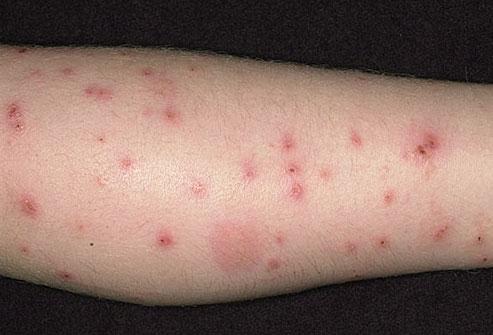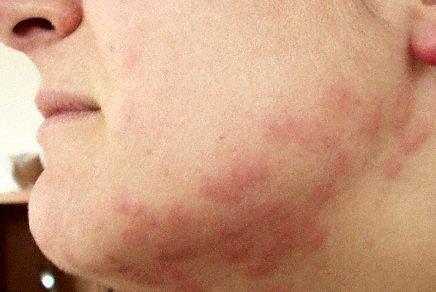What are Fleabites?
Fleabites have red bumps resultant of bites suddenly appear on your skin, there are two major culprits. These common blood suckers (fleas and bedbugs) are found in homes and cause a lot of discomfort for the inhabitants both humans and pets.
Causes
These are caused by fleas. Fleas are flightless insects that are brown, flattened sideways and when mature about 3mm long.
They survive as external parasites consuming blood from warm blooded animals and live in the fur or feathers of the host. They have mouth parts adapted for piercing skin and sucking blood and strong hind legs adapted for jumping long distances.1
They are caused by bedbugs. Bedbugs are small ovular reddish brown flightless insects that feed off blood sucked from humans or other warm blooded animals. They live in upholstery and furniture, but prefer carpets, mattresses, bed linen and bed frames. They mostly bite at night.4

Flea bites on arm
Symptoms
With flea bites, the symptoms may be as follows:
- Red swollen bump appears on bitten areas within thirty minutes
- An irritatingly constant itchy rash spreads around the affected area
- If one scratches the bumps, they may turn into blisters in two days
- Itching also causes the area to bleed and become infested
- Allergic individuals may suffer hives, chest pains or difficulty breathing.
A person who has been bitten by bedbugs will show symptoms such as:
- A big bump that is hard to touch appears at the site of the bite after sometime depending on sensitivity
- The bump has a dark red spot at the centre and depending on sensitivity to the bite, an inflammation may surround the bite
- Bites appear in a line but some rare times occur in clusters
- Itchiness at the affected area occurs in some people, but it is not as persistent as that of a fleabite.

Diagnosis
It is important to differentiate the signs and symptoms of flea bites and bedbug bites. Here is some useful information to help you distinguish between the two insect bites:
- Flea bites mostly occur on the lower half on the body such as ankles and calfs
- Bedbug bites are often on parts of the body likely to be exposed at night such as the face, arms, and legs
- Flea bites have one puncture mark and cause small bumps that are usually clustered in threes and surrounded by red skin rash that causes intense itching. Flea bites are mostly felt immediately.
- Bedbug bites cause a big hard bump usually with a dark red spot at the centre of the bump. They usually occur linearly but may cluster as well. Bedbug bites do not always cause rashes or itching therefore some people do not notice them immediately.
- Fleas bite continuously provided a host is in the immediate environment
- Bedbugs are known to bite at night and usually periodically
- Fleas leave red-brown bug dirt that when moist turns into a dark stain
- Bedbugs leave black speckling of bug dirt usually seen in beds.
Treatment
When you have been bitten by fleas, the following treatment options may help:
- Wash the area surrounding the bite with warm water and soap. Pat dry with a clean towel.
- Relieve itching by applying a topical anti-itch cream, calamine lotion or hydrocortisone
- Do not shower with extremely hot water as it exacerbates itching
- Allergic people should take antihistamines to lower the odds of getting an allergic reaction
- If the rash does not clear after a few week or becomes infected, see a doctor for prescription of antibiotics.
Bedbugs are not known to cause any diseases and their bites disappear without treatment within duration of one to two weeks. Allergic people however, should take antihistamines and see a doctor should any adverse effects like hives occur.
- If there is an allergic reaction, a doctor will recommend use of corticosteroid, antihistamine, or epinephrine in the case the allergy is severe.
- An infection can be treated with an antibiotic. In case the infection is mild, a doctor will recommend that you have an antiseptic medication rather than an antibiotic.
- Itching may be treated using a prescription antihistamine. A corticosteroid may also be applied to the itchy bites.
Home Remedies
The following home remedies can help when you develop itching as a result of bedbug and flea bites:
- A paste made from a mixture of water and baking soda can be applied to the skin and left for one hour before washing off
- Dab the bites with cotton wool dipped in St. Jonhn’s wort, witch hazel or lemon juice
- Smear the bites with aloe-vera extract.
- Take a warm bath with oatmeal or half a cup of peppermint oil.
Complications
Bedbugs are not known to cause any disease, but some people are allergic to the enzymes found in the saliva and suffer hives, chest pains, and other allergic reactions.
Fleas are responsible for spreading many diseases depending on their animal host most notably the bubonic plague from black rats. They also cause many diseases amongst pets and can make young animals anemic if they draw too much blood. Fleas may also transmit diseases between pets, especially cats and humans.
Some people are allergic to fleas and develop hives and rashes, or when scratched, the bitten area swells and forms blisters, which may break and lead to secondary infections. Some fleas infest your skin and cause skin infections.
Prevention
Fleas get into most home via household pets and are hard to eliminate without an exterminator because they reproduce quickly with eggs that take two weeks to hatch and can live up to three months. To prevent a flea infestation in your home:
- Wash your pets with pet shampoo that kills all pests hidden on their fur.
- Do not allow dust to accumulate. Frequently vacuum your floors and furniture. Steam clean your carpet.
- Mow the lawn if pets are often outdoors.
- Get a flea collar or another treatment options for all household pets.
- In case an infestation is already underway, use a pest control service.
Due to their highly adaptable nature, an infestation by beg bugs usually can only be completely eliminated by a pest control expert. To prevent bed bugs inhabiting your home try the following methods:
- Use essential oils that repel bed bugs on your clothing and luggage when travelling. This include cinnamon, lavender, clove, lemon grass and thyme.
- Clean (dust and vacuum) your house regularly paying attention to the carpets, rugs, far corners and crevices. Dispose of the vacuum cleaner contents immediately in a sealed plastic bag.
- Clear out all the clutter in your house
- Use a protective cover for your mattresses, seat cushions and box springs in order to eliminate many hiding places.
- Isolate your home from pests in your neighbors’ houses by installing a door jam or door sweep to seal off the gap below the door. Also repair any cracks and damage in the walls or ceilings.
References
- Wikipedia: https://en.m.wikipedia.org/wiki/Flea
- Differences Between Flea Bite and Bedbug Bites. MD Health: https://mdhealth.com/differencesbetweenfleabitesandbedbugbites
- Flea bites vs. Bed bug bites- Which is it? Healthline: https://healthline.com/fleabitesvsbedbugbiteswhichisit
- Bedbug. Retrieved from Wikipedia: https://en.m.wikipedia.org/wiki/bedbug
- Flea Bites vs. Bed Bug Bites- Symptoms and Differences: Doctors Health Press: http://www.doctorshealthpress.com/general-health-articles/difference-between-flea-bites-and-bed-bug-bites
- How to Prevent Bed Bugs? Wikihow: http://www.wikihow.com/Prevent-Bed-Bugs
- Bedbugs: Diagnosis and treatment. https://www.aad.org/public/diseases/itchy-skin/bedbugs#treatment
- http://healthywa.wa.Fleas. https://medlineplus.gov/ency/article/001329.htm
- Flea Bites on Dogs: What Do They Look Like?. https://www.petmd.com/dog/parasites/flea-bites-dogs-what-do-they-look
- Flea Bites On Dogs: What They Look Like and How to Treat Them. http://pesthacks.com/flea-bites-on-dogs/
- What Do Flea Bites Look Like on Dogs? http://www.akc.org/content/health/articles/flea-bites-on-dogs/
- Flea Bites on Children. https://www.buzzle.com/articles/flea-bites-on-children.html
- Flea bites in children: the more they are dangerous and how to treat them. http://en.nsns.biz/bloxi-v-kvartire_ukusy-blox-u-detej.html
- Flea Bites on Humans: How to Identify and Treat. https://stoppestinfo.com/148-how-to-identify-and-treat-human-flea-bites.html
- Sand Fleas- Bites and Treatment. http://longtimenoflea.com/sand-fleas-bites-and-treatment/
- What’s the Difference Between Flea Bites and Bedbug Bites? https://www.healthline.com/health/flea-bites-vs-bed-bug-bites
- How to Tell If You Have Bed Bugs or Fleas. https://www.terminix.com/blog/diy/how-to-tell-if-you-have-bed-bugs-or-fleas
- 15 Powerful Methods to Treat and Prevent Flea Bites On Humans & On Pets. https://www.pestwiki.com/treat-prevent-flea-bites/

Thanks for this great post. In addition to preventing this kind of condition, I believe that we should always keep a healthy surrounding especially if we have children roaming around.